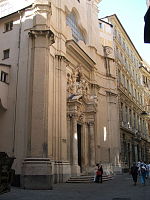Genoa: Le Strade Nuove and the system of the Palazzi dei Rolli is a UNESCO World Heritage Site which includes a number of streets and palaces in the center of Genoa, in Northwestern Italy.
The Strade Nuove (Italian for "New Streets") are a group of streets built by the Genoese aristocracy during the expansion of the city at a time when the Republic of Genoa was at the height of its financial and seafaring power. These are Via Giuseppe Garibaldi (1558-1583, formerly Strada Maggiore or Strada Nuova) and Via Balbi (1602-1620, formerly Strada Balbi), later followed by Via Cairoli (1778-1786, formerly Strada Nuovissima).
The Palazzi dei Rolli (Italian for "Palaces of the Lists") are a group of palaces - most of which also date from the late 16th and early 17th centuries - which were associated to a particular system of ‘public lodging’ in private residences, whereby notable guests on State visit to the Republic were hosted in one of these palaces on behalf of the State.
On 13 July 13, 2006, forty-two of the 163 palaces originally included in one the five public list called "Rolli" (Italian for "lists") were selected as a World Heritage Site by the UNESCO special committee meeting in Vilnius (Lithuania). The site includes an ensemble of Renaissance and Baroque palaces along the so-called ‘new streets’ (Strade Nuove), which offer an extraordinary variety of different solutions, achieving universal value in adapting to the particular characteristics of the site and to the requirements of a specific social and economic organization. They also offer an original example of a public network of private residences designated to host state visits.On January 20, 2007, UNESCO unveiled a plaque in via Garibaldi, the former Strada Nuova, explaining the reasons for inclusion of the Strade Nuove and the system of the Palazzi dei Rolli within the World Heritage Sites:
The largest homes, various in shape and distribution, that were chosen at random in the lists (rolli) to host visits of state. The buildings, often built on sloping land, formed of a stepped atrium - courtyard - staircase - garden and rich interior decorations, express a singular social and economic identity and commencement of modern age urban architecture in Europe.Some of the Palazzi dei Rolli are used today as public buildings, museums, offices and private residences. Among the palaces open to the public, Palazzo Rosso, Palazzo Bianco and Palazzo Doria Tursi jointly constitute the Strada Nuova Museums located in via Garibaldi.












